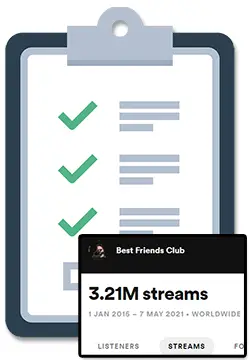Although social media can be a useful tool, there are several overlooked reasons that social media can truly be bad for artists and musicians.
I’m writing this article from a place of experience, I’ve tried a bunch of different things to grow my social media presence and I want to share what to watch out for and what works with you.
The 6 reasons that social media is bad for artists are:
- Reach throttling
- Lifecycle of a post
- Little longterm recommendation
- Wasted time and energy
- Clowning around
- Not all social media platforms have scheduling
To learn more about these 6 reasons, the 3 benefits to social media for artists and musicians, and how you can up your social media game, simply keep on reading, my friend. 🙂
The 6 Reasons Social Media Is Bad For Artists & Musicians
If you (like me) aren’t a huge fan of using social media, you may be surprised to find that you are right in realizing that social media can be a bad thing for artists and musicians.
If you hate posting and don’t even use your own personal account to post often, social media can just seem like a necessary evil in music marketing.
..but is it really?
Considering there are so many other things you can be doing instead of social media, let’s go through the 6 reasons that social media isn’t great for artists and musicians:
1. Reach throttling
Reach throttling is when the organic reach (the number of people a post will naturally see without paid promotion) is being limited so that your posts don’t reach as many of your followers or relevant users on a social media platform.
Why do social media platforms do this?
To encourage you to spend money on ads to reach those people (even if they’ve already followed you).
As a platform introduces new features (like Instagram did with Reels), these features may not have throttling at first in order to encourage users to start actually using the new feature.
However, social media platforms will eventually want to monetize (aka make money) off that particular feature and will inevitably introduce reach throttling.
2. Lifecycle of a post
The lifecycle of a post is how long a post will be eligible to gather free views from organic reach.
With Instagram, the lifecycle of a post can be as little as 24 or 48 hours unless it goes viral.
This means that all of that effort that you put into creating a photo or a 30 – 50 clip, only gets shown to people for a few hours.
3. Little longterm recommendation
Because most social media platforms are based on news feeds instead of search results, there is no way for your post to rank in a search engine and continue to get organic traffic for years to come.
In addition to this, social media platforms tend to favor recommending newer content, so your older posts really only work for you in the first 24 – 48 hours.
Compared to YouTube or a blog that ranks in Google search, your views go down over time instead of constantly going up.
What would you rather spend your time creating: a post that goes away in a few hours or an asset that continues to increase views and generate traffic over time?
4. Wasted time and energy
All of this can really add up to wasted time and energy.
If you are trying to post every single day, revolving your world around Instagram or TikTok posts, you get very little in terms of organic and long-term reach and have less time to focus on creating music and marketing music.
Essentially, you are working for the social media platforms instead of creating content that works for you.
5. Clowning around
Let’s get real, real honest here.
Some of the things that people think are what needs to be done in order to get views from platforms like TikTok… straight up make you look like a clown.
Personally, I’m not looking to be the next Charli D’Amilo and I don’t want to feel like a clown making dance videos or skits.
If that’s your thing, then great, you do you!
But I think most musicians and artists don’t want to do things that feel inauthentic just for views and followers.
6. Not all social media platforms have scheduling
Social media scheduling is the act of taking a batch of content and scheduling it to automatically post throughout the week so that you do not have to manually post each piece of content.
In short, this feature can save you a lot of time and energy, since you can post lots of content in one go and from your computer instead of your phone.
However, not every social media platform has the feature which means you need to create the content on your phone or transfer it over from your computer, wake up at the exact time you want to post, and manually post it then and there.
I personally used to do this when I was trying to grow my Instagram account and the scheduling feature was not available and it was draining and really frustrating.
The Top 3 Benefits Of Social Media For Artists
Although it can have its downsides, there are also some clear benefits of using social media as an artist or musician.
The top 3 benefits of social media for artists are that you can test ideas to get feedback, understand the momentum and hype for your project, and share your successes with a community that you are building around your music.
Let’s dive into these 3 benefits in more detail:
1. Testing ideas and getting feedback
Social media can be a great platform to test new ideas and gather feedback.
These can be musical ideas, artwork ideas, content ideas, new release ideas, etc.
You can see how people react in terms of the number of likes, comments, direct messages, and new followers.
Plus – you can also look at what kind of things people are saying as well.
Ultimately, this can help you understand your audience better and give you a good idea of what direction you should go in with your music and content.
2. Understand momentum and hype for your project
Social media can be a great way to tell what kind of momentum and hype is being built up around you and what you are doing.
You can really get a good vibe to see if people are interacting with you more from month to month, getting excited about upcoming releases and if your numbers are growing.
This can be a great feeling and can let you know that you are on the right track and that your fanbase is growing and is engaged.
3. Share successes with your community
As you continue to grow as an artist, you will be hitting neat milestones like hitting higher and higher stream counts on Spotify, getting cool playlist adds, press, interviews, etc.
A great thing about social media is that you can use it to share your successes with your community.
Of course, there is there’s a fine line between bragging and sharing a success but in most cases, your audience wants to see that you are reaching new heights and to have some validation that they were right to back your career and support you!
Your audience’s support is what helped you reach these successes in the first place, so share it with them so you can celebrate together. 🙂




